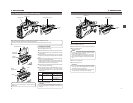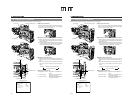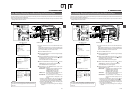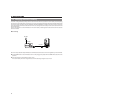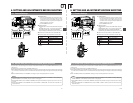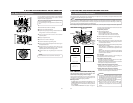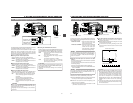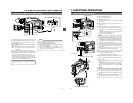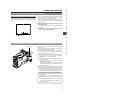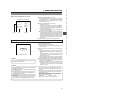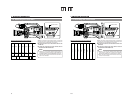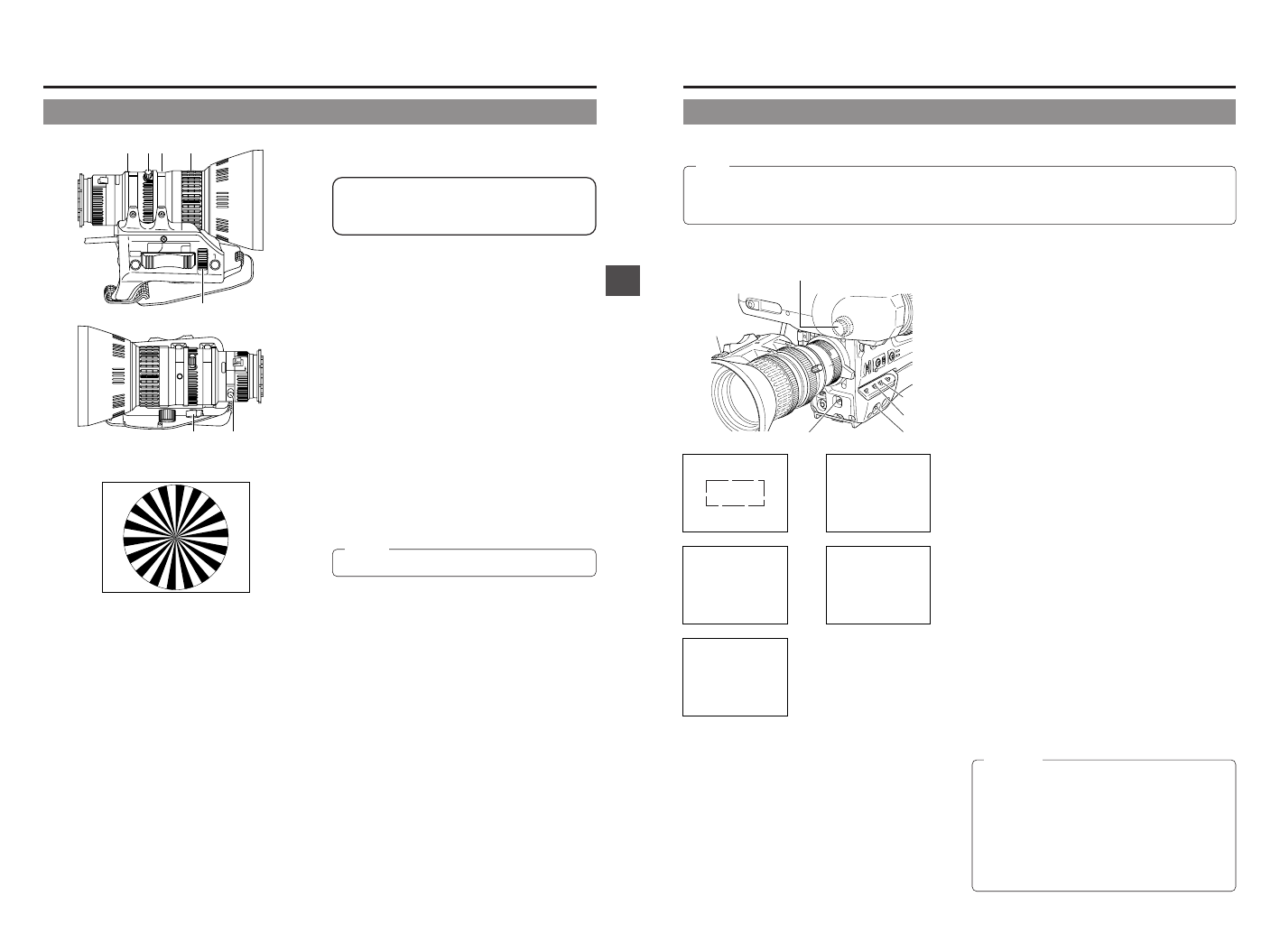
49
6. SETTING AND ADJUSTMENTS BEFORE SHOOTING
M
RET
WT
A
MACRO
4.6. 5.3.
1.
7.8.10.2.
6-5 Back Focus Adjustment
Siemens star chart
It is only necessary to perform this when the lens is attached
for the first time or when focusing is not correct in both the
telephoto and wide-angle positions.
It is easier to adjust back focus when the subject is more
than 3 meters from the camera.
The optimal subject for this adjustment is a Siemens star
chart.
1.
Set the IRIS mode switch to M (Manual).
2.
Set the zoom mode to M (Manual).
3.
Open the iris by turning the iris ring. If the illumination is too
strong, reduce it or move to a darker place.
4.
Turn the zoom lever until the lens is at the maximum
telephoto position.
5.
Bring the subject into focus.
6.
Set the lens to maximum wide-angle.
7.
Loosen the back focus ring retaining knob.
8.
View the same subject and adjust the back focus ring for
the best possible focus.
9.
Repeat steps
4
. through
8
. about three times for fine
adjustment until the subject remains in focus in both the
telephoto position and the wide-angle position.
10.
Tighten the back focus ring retaining knob to secure the
ring.
MEMO:
ACCU FOCUS can also be used in the above step
3
.
50
6. SETTING AND ADJUSTMENTS BEFORE SHOOTING
Two kinds of white balance adjustment results can be stored in
memories AUTO1 and AUTO2.
Ⅲ Adjustment procedure
1.
Set the following switches.
● Set the POWER switch to ON.
● Set the OUTPUT switch to CAM-AUTO KNEE.
● Set the IRIS mode switch of the lens to A (Auto).
2.
Set the FILTER knob according to the current lighting.
3.
Set the WHT.BAL switch to A or B.
4.
Place a white object near the centre of the screen under
the same lighting conditions as the target subject and zoom
in to fill the screen with white.
5.
Tilt the AUTO WHT./ACCU FOCUS switch upward (to AUTO
WHITE) once and release it.
“AUTO WHITE A, B OPERATION” is displayed in the
viewfinder while the auto white balance adjustment circuit
operates.
When correct white balance is obtained, the approximate
color temperature is displayed together with “AUTO WHITE
A, B OK” for about 5 seconds.
Error messages
If the adjustment ends abnormally, an error message, as
described below, blinks for about 5 seconds.
● NG: OBJECT (Improper object)
Displayed when there is not enough white color on an object
or the color temperature is not suitable.
Replace the color temperature conversion filter or use another
white object and re-adjust the white balance.
● ERROR: LOW LIGHT (Insufficient illumination)
Displayed when the illumination is dim. Increase the
illumination and then re-adjust the white balance.
● ERROR: OVER LIGHT (Excessive illumination)
Displayed when the light is excessively bright. Decrease the
illumination and then re-adjust the white balance.
FULL-TIME AUTO WHITE BALANCE (FAW)
The FAW function adjusts the white balance value
automatically as the lighting condition changes.
This mode is convenient when you have no time to adjust the
white balance or when the camera is moved frequently in and
out of places under different lighting conditions.
■Setting procedure
The FAW function can be activated with the FAW item on the
CAMERA OPERATION menu screen. The FAW function can
be allocated to one of the white balance switching switches
A, B, or PRESET.
☞ See “CAMERA OPERATION menu screen” on page 75.
6-6 White Balance Adjustment
Since the color of light (color temperature) varies depending on the light source, it is necessary to re-adjust the white balance when
the main light source illuminating the subject changes.
Note
When a subject illuminated by a halogen lamp with a color temperature of 3,200K is shot while the color temperature conversion
filter setting is set to 5,600K, 5,600K+1/8 ND, or 5,600K+1/64 ND, a proper white balance adjustment and (FAW) Full Time Auto
White balance may not be accomplishable. In this case, change the color temperature conversion filter setting to 3,200K and
then carry out the white balance adjustment and (FAW) again.
● Do not adjust using any highly reflective objects, such as metal, etc., as this may result in improper white balance adjustment.
WHITE BALANCE ADJUSTMENT
1.
1.
1.
5.
3.
2.
Iris mode
switch
FILTER knob
AUTO WHT.
/ACCU FOCUS switch
WHT.BAL
switch
OUTPUT
switch
POWER
switch
AUTO WHITE A
OPERATION
AUTO WHITE A
OK <3200K>
AUTO WHITE A
NG:OBJECT
AUTO WHITE A
ERROR:LOW LIGHT
AUTO WHITE A
ERROR:OVER LIGHT
During operation
Improper object
Result message
Insufficient illumination
Excessive illumination
CAUTION:
● The FAW (Full-time Auto White balance) function cannot
provide optimum white balance with a subject outside
the FAW adjustment range, for example when it contains
only a single color or not enough white color.
● The accuracy of the FAW (Full-time Auto White balance)
is inferior to that of the Auto white balance.
● When the power is turned on with the FAW mode
selected, it takes about 10 seconds for the FAW
adjustment to be completed. Do not shoot within this
interval.



